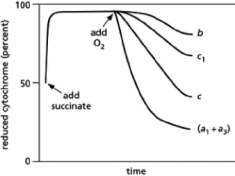In 1925, David Keilin used a simple spectroscope to observe the characteristic absorption bands of the cytochromes that participate in the electron-transport chain in mitochondria.A spectroscope passes a very bright light through the sample of interest and then through a prism to display the spectrum from red to blue.If molecules in the sample absorb light of particular wavelengths, dark bands will interrupt the colors of the rainbow.His key discovery was that the absorption bands disappeared when oxygen was introduced and then reappeared when the samples became anoxic.Subsequent findings demonstrated that different cytochromes absorb light of different frequencies.When light of a characteristic wavelength shines on a mitochondrial sample, the amount of light absorbed is proportional to the amount of a particular cytochrome present in its reduced form.Thus, spectrophotometric methods can be used to measure how the amounts of reduced cytochromes change over time in response to various treatments.If isolated mitochondria are incubated with a source of electrons such as succinate, but without oxygen, electrons enter the respiratory chain, reducing each of the electron carriers almost completely.When oxygen is then introduced, the carriers oxidize at different rates, as can be seen from the decline in the amount of reduced cytochrome (see Figure 14-27).Note that cytochromes a1 and a3 cannot be distinguished and thus are listed as cytochrome (a1 + a3).How does this result allow you to order the electron carriers in the respiratory chain? What is their order? 
Figure 14-27
Definitions:
Group Therapy
Therapy conducted with groups rather than individuals, providing benefits from group interaction.
Individual Therapy
A form of psychotherapy where one-on-one sessions between a therapist and a client focus on the client's issues and ways to resolve them.
Social Functioning
Social functioning refers to an individual's ability to perform and fulfill expected roles within society, through interpersonal relationships, work, and social activities.
Psychoanalysis
A therapeutic approach developed by Sigmund Freud that seeks to explore the unconscious mind's influence on behavior through techniques like dream interpretation and free association.
Q9: Which of the following is TRUE regarding
Q10: Thermal motion promotes lateral position exchanges between
Q42: A military commission is composed of:<br>A)a panel
Q46: How are most eukaryotic transcription regulators able
Q48: Name the catabolic process that use substrate-level
Q52: Which of the following statements about microtubules
Q57: Sodium dodecyl sulfate (SDS) and Triton X-100
Q58: Describe the steps by which the F<sub>0</sub>
Q59: For each of the following sentences,
Q68: Which of the following is not a